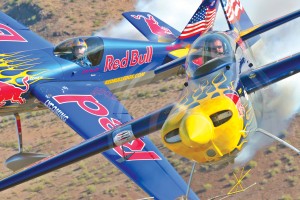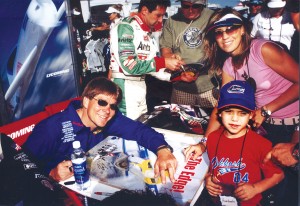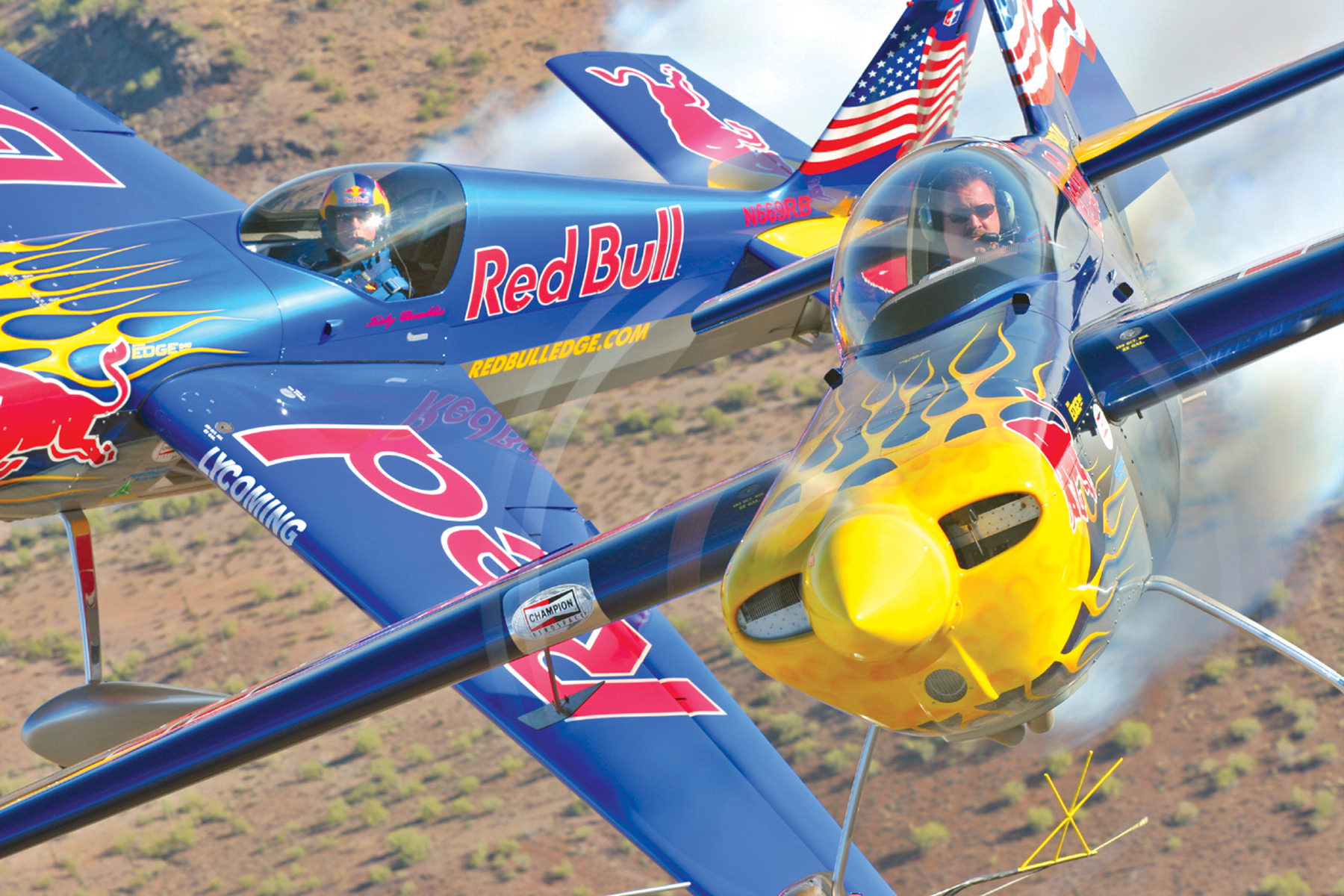By Bob Shane

L to R: Kirby Chambliss is piloting the single-place Red Bull Edge 540 and Pat McGarry the two-place Red Bull Edge in an unorthodox formation.
When it comes to extreme aerobatic airmanship, Kirby Chambliss is way up there with the best of the best. While most aerobatic pilots specialize in one segment of aerobatic flying, Chambliss does it all. Even though he says, “It’s usually an either/or situation, since it’s tough to do everything well,” he still manages to dominate most areas of aerobatic flight.
With 50 air shows on his schedule for this year, he also competed in the U.S. National Aerobatic Competition in Sherman, Texas, winning the event for the fifth time. In addition, he competed in the World Aerobatic Competition in Spain, where he was the captain of the U.S. team and the top American entry, finishing eighth overall.
In competition, everything has to be perfect.
“You essentially have to fly like you’re on a rail,” he said. This quest for excellence brings a discipline to the flying, which improves the flying overall.
This year, Chambliss competed in six of the seven Red Bull Air Races, finishing in third place for the series. Making sponsor-related appearances and flying as a captain for Southwest Airlines completed the full schedule for 2005. The demands of being on the road so much left a mere 50 days Chambliss was able to spend at his desert home in Arizona.
Home for Kirby, his wife Kellie and daughter Karly Nicole, who was born in March of this year, is a private piece of real estate near Arizona City, Ariz. Bordered by the Sawtooth Mountains, in the shadow of Wildcat Peak, sits the Flying Crown Ranch.
Those of you who are old enough may recall another Flying Crown Ranch, on a TV series that aired in the 1950s called “Sky King.” Another Kirby, Kirby Grant, who lived at the ranch, played the character Sky King, America’s favorite flying cowboy. Each episode was jam-packed with flying footage of Sky King’s airplanes, first a Cessna T-50 Bobcat and then a Cessna 310B, named “Songbird.”
Chambliss’ dream house is built on a private runway adjacent to a standard competition aerobatic box marked off on the desert floor, within the Chambliss property line. It’s very convenient having a runway outside your back door when your training regimen requires practicing three times a day.
Chambliss, now a congenial Arizonan, was born in Corpus Christi, Texas, in 1959. From childhood, he wanted to be a pilot. His dad was a pilot and Chambliss helped him build several airplanes. He worked as a line boy refueling aircraft while in high school, starting his flight training at age 17.
He got his commercial rating, worked as a flight instructor and hauled freight at night. He later flew a corporate Citation jet for La Quinta Motor Inns. It was working for La Quinta that Chambliss got his first exposure to aerobatics. The chief pilot at La Quinta required all his corporate pilots to take formal aerobatic instruction as part of their flight proficiency training. He wanted them all to be able to recover from being upside down.
After getting his ATP certificate with a Boeing 737 type rating, at age 24, Chambliss went to work for Southwest Airlines. Five years later, he became the youngest captain flying for Southwest. The airline job paid enough money that Chambliss could afford to buy his first airplane, a Pitts S2A. In 1993, he switched to the Edge monoplane.
While growing up, his heroes were all pilots. That included his father. Chambliss was particularly in awe of renowned aerobatic pilot Leo Loudenslager, a seven-time winner of the U.S. Nationals aerobatic competition and the World Aerobatic Champion in 1980.

One activity Kirby Chambliss enjoys is talking to youth and signing autographs between aerobatic performances.
“Loudenslager was ahead of his time,” Chambliss said.
There are only a few professional aerobatic pilots that make big money doing the air show circuit. It takes a lot of work and energy to get to that point.
“It’s all about you,” Chambliss said. “You really have to want it. It takes a lot of time to gain the experience to do the things I do.”
The aerobatic air show is an art form that is never the same. Each show is a function of how the pilot feels at that moment.
“I am an artist painting a picture in the sky,” Chambliss said. “The airplane is the paintbrush that I use to try and paint that perfect picture.”
In aerobatic flying, things are happening very fast.
“When I fly, it’s all I think about,” Chambliss said. “It requires 100 percent concentration. All my thoughts have to go into what I’m doing. Everything I do is calculated. I’ve done it a thousand times before.”
Having all that experience doesn’t mean Chambliss doesn’t seek the counsel and sage advice of a good coach. Sergei Boriak was his trainer from 1997 to 2003. He then switched to Patrick Paris. Chambliss spends two or three sessions per year with his coach, mainly to do a lot of clean up.
“I know what to do, I just need to be reminded about it,” says Chambliss.
Aerobatic flying is the most demanding form of flight and the most dangerous. It’s a journey across the sky, exploring the absolute limits of human skill and the structural integrity of a machine. It’s a contest where man and airplane are pushed to the brink, a millisecond away from human peril and shattered plastic, should one or the other fail. It’s an aerial ballet, a balancing act between life-preserving lift and death-inflicting drag. When done perfectly, it’s a testimonial to man’s supreme triumph over gravity.
Aerobatic flight involves extremes: How low you can go or how tight you can turn. Going from 260 knots to zero knots in a matter of seconds. Pulling high G’s, both positive and negative. Putting the aircraft in a disorienting gyroscopic tumble or high rate of descent that the pilot has to manage before hitting the ground.
It would appear that aerobatic flight is an exercise in contradiction, asking the airplane to fly, but begging it to stall.
The plane and sponsors
The aircraft currently flown by Chambliss is the Zivco Edge 540. It’s an advanced unlimited class aerobatic aircraft with the highest thrust-to-weight ratio of all of the alternative competition aerobatic aircraft flying today.
While other airplanes may be faster, its forte is performance. It can start and stop maneuvers quickly. The fuselage, a steel tube structure, is lighter and stronger than one that is all-composite. It’s designed to take over 15 G’s of sustained loading. A Lycoming 327-plus-HP engine is used to power the aircraft.

Having a dream house built on a private runway makes it easy for Kirby Chambliss to claim, “I can fly upside down right past my door!”
Today, Chambliss is positioned on the top of his game. Consequently, he’s earned the support of a number of sponsors, some of which are major league. His sponsors include Red Bull, Zivco Aeronautics (builders of the Edge 540), Lycoming, Unison, Tempest, Aeroshell, MT Propellers, Barrett Engines and Chandler Air Service.
Red Bull and Chambliss are a perfect fit. Red Bull is about “extreme” and so is Chambliss. Red Bull dominates the energy drink market and Chambliss dominates aerobatics. Red Bull’s founder, Dietrich Mateschitz, loves flying, racing and sharing these two passions with others.
According to Chambliss, Red Bull empowers the athletes it sponsors to go out and do their best. At home and on the road, Chambliss seems to have an endless supply of the Red Bull energy drink he takes before flying because he feels it increases his alertness.
No rabbit’s foot in this cockpit
Chambliss is not a believer in luck. He has no special shirt and is not superstitious about flying on Friday the 13th.
His success is all about training and having a supportive family. His wife Kellie is an accomplished pilot, flying a Twin Otter at the Sky Dive Arizona jump center. She also pilots the family’s Beech Baron support aircraft for Chambliss Aerobatics.
When Kirby has an air show to go to, the back of the Baron is converted into a flying nursery, complete with car seat, crib and stroller, for Karly Nicole. The Baron becomes the proverbial “family station wagon.”
For all air show performers on the top of their profession, there’s the need to refresh their show product. We can only speculate on what new element Chambliss may incorporate into future air shows.
He’s explored the entire envelope of the Edge 540 that he’s currently flying. In the future, don’t be surprised to see him in a new airplane design developed in concert with sponsor Zivco Aeronautics. This rumored one-of-a-kind aircraft could be the next major chapter in aerobatic flight for Kirby Chambliss.











